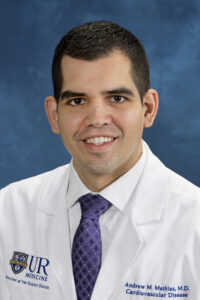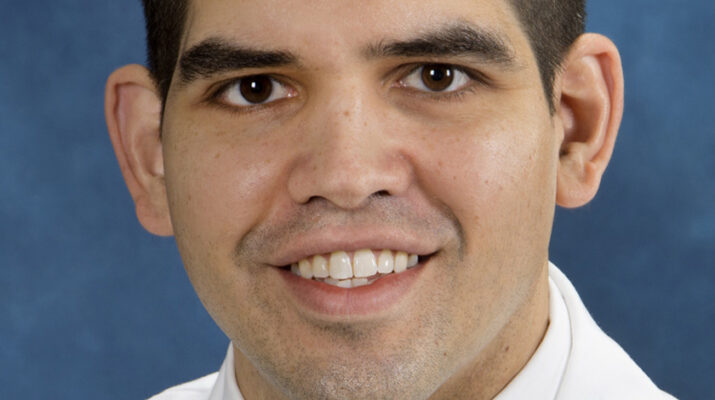By Ernst Lamothe Jr.

For decades, one health ailment continues to dominate as the most severe. Heart disease is the leading cause of death for men, women and people of most racial and ethnic groups in the United States, according to the Centers for Disease Control and Prevention.
One person dies every 34 seconds in the United States from cardiovascular disease.
It is a condition that remains a health issue even globally. The World Health Organization states cardiovascular diseases are the leading cause of death globally, taking an estimated 17.9 million lives each year.
Cardiovascular diseases are a group of disorders of the heart and blood vessels and include coronary heart disease, cerebrovascular disease, rheumatic heart disease and other conditions.
“Heart disease or the deposition of cholesterol plaque in our arteries, is both one of the most common heart issues as well as the top cause of death in adults,” said physician Andrew Mathias, who is part of UR Medicine Cardiac Care in Rochester. “This plaque can build up over time, especially in people who smoke or have high blood pressure, high cholesterol or diabetes. The reality is, as individuals, we have a lot of power to minimize the risk of heart disease by our lifestyle choices such as eating right, exercising regularly and avoiding tobacco use.”
Mathias gives five aspects of heart health that patients should know.
1. Family history matters
Having a family health history of heart disease makes you more likely to develop heart disease. In some cases, having family members with heart disease at age 50 or younger can be a sign of familial hypercholesterolemia, a genetic disorder that causes high cholesterol, according to the Centers for Disease Control and Prevention. Health officials suggest taking time to collect your family health history of heart disease and share this information with your doctor and other family members.
“Family history of early heart disease, especially heart attack, is an independent risk factor in addition to the other traditional risk factors, such as smoking, high blood pressure, high cholesterol, diabetes,” said Mathias. “If you have a family history of a primary relative, which is your mother, father or sibling, who had a heart attack before the age of 50 for men or 60 for women, talk with your physician about whether more aggressive screening or risk-factor modification is needed.”
2. Men and women have different attacks
The most common symptom of a heart attack for both men and women is pain or pressure in the center or left-center of the chest. Recently, studies have shown that women experience heart attacks quite differently than men. Both men and women can also experience pain in the jaw, neck, arms, shoulders, back or upper abdomen.
“Women may also experience nausea, shortness of breath, lightheadedness, or fatigue. If you experience a sudden onset of a combination of these symptoms, it could be a heart attack and you should dial 911 to get medical attention as soon as possible,” said Mathias.
“Men and women should be aware of the signs of a heart attack as well as preventable risk factors that contribute to heart disease and increase the risk of both heart attack and stroke.”
3. Youth vs adults
There can be significant differences between heart ailments for youth and adults. Patients who are younger than 18 typically get diagnosed with some type of congenital heart disease.
“Fortunately, there are not any heart issues that are extremely common in children and youth. Abnormal heart rhythms and genetic or congenital heart diseases are the most prevalent heart issues for youth,” said Mathias. To know more about heart rhythms and prevention, you can visit this website, https://aedadvantage.ca/, for more information.
4. Myths
It’s easy to be fooled by misconceptions. Relying on false assumptions can be dangerous to your heart.
“A common myth is that heart disease is primarily a disease that affects men. This is far from the truth,” said Mathias. “Heart disease is the leading cause of death for both men and women. Population health studies show that outcomes for women who have heart attacks lag behind men partially due to the lower recognition of their heart attack symptoms even among health care professionals.”
5. Improving your odds
There are a lot of ways people can improve heart health and reduce their risk of heart disease. Healthy behaviors like watching your diet and exercising regularly are important, along with avoiding the use of tobacco, alcohol or drugs.
“To maintain a healthy heart, choosing a primarily plant-based diet with limited intake of red meats, saturated fats and sugary foods is important,” said Mathias. “Try to exercise 30 minutes a day, five days per week doing an activity that gets your heart rate up, like a brisk walk. The perfect diet and exercise plan will be different for everyone. One of the keys is finding foods and exercises that you enjoy and it will be easier to maintain these behaviors over time.”
In addition, your cholesterol level is a major factor in the development of artery plaque and heart attack.
“Diet and exercise and maintaining a healthy weight are important for maintaining a healthy cholesterol level. Knowing your cholesterol is a good way to quantify your risk for heart disease. Your doctor can order a simple blood test to monitor it,” he added.

